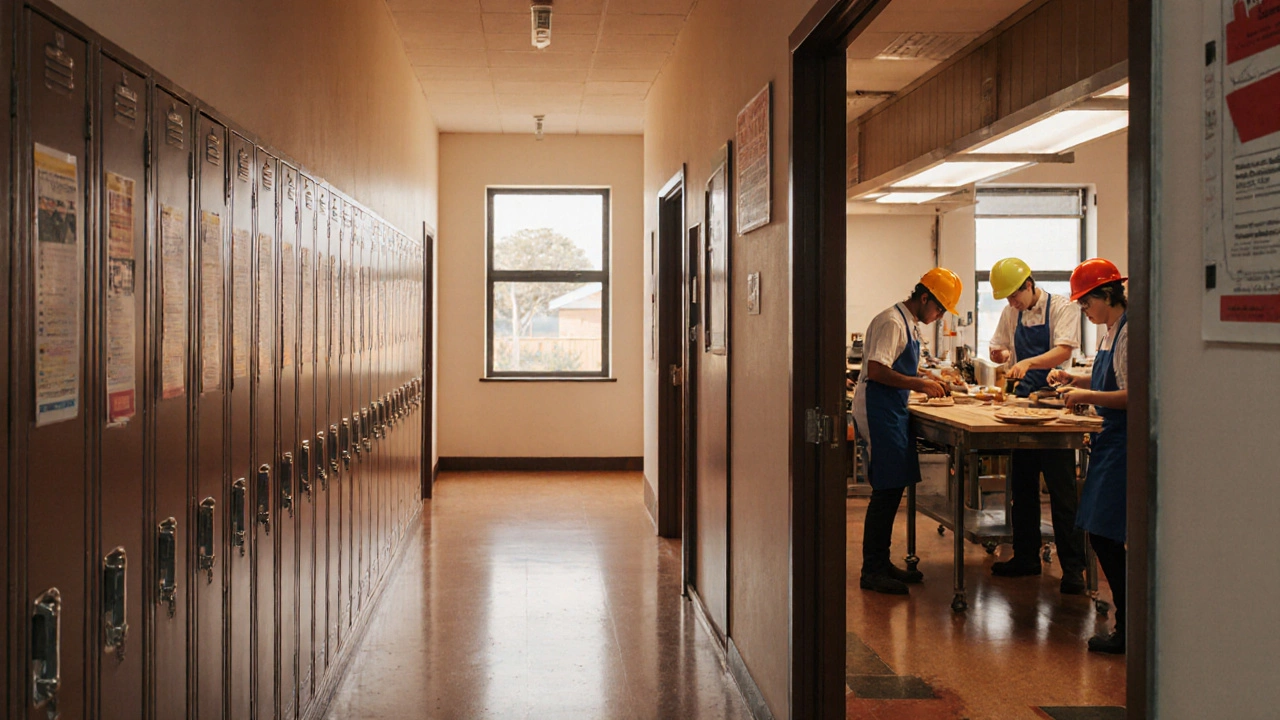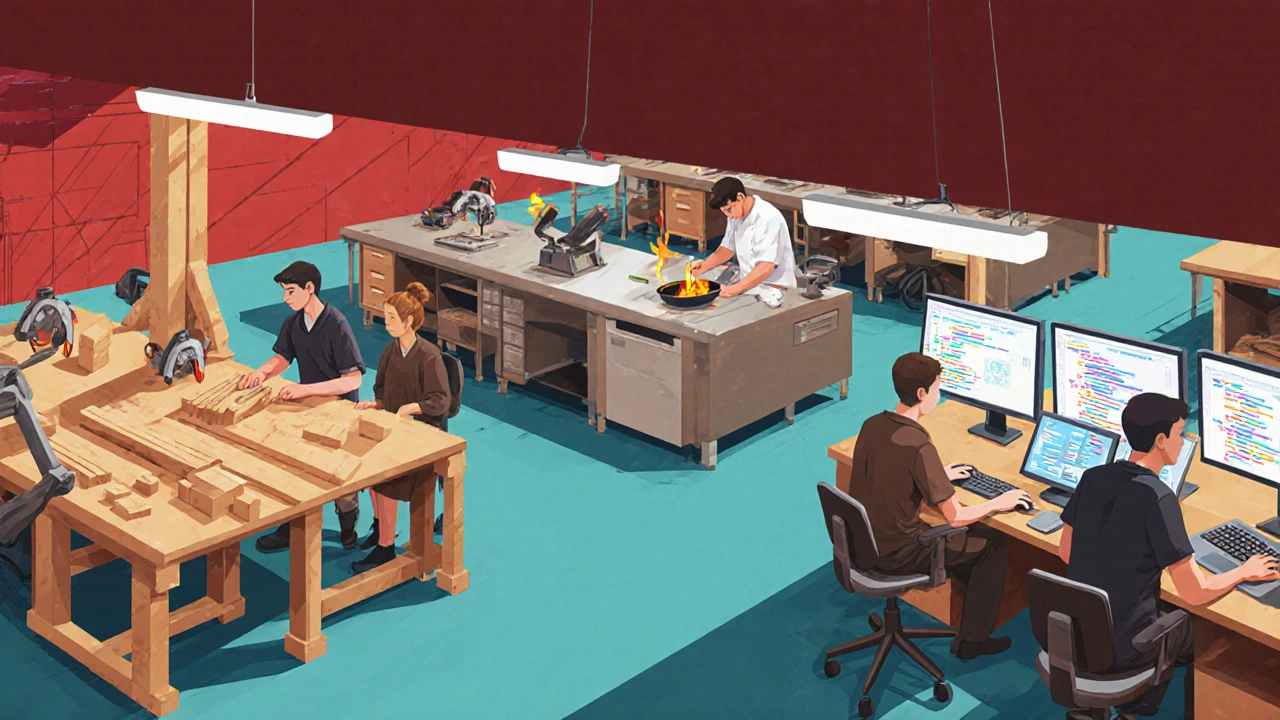Understanding Vocational Education in Schools: A Complete Guide

Vocational Career Pathway Calculator
Select your interests and skills to discover vocational pathways that match your strengths and career goals.
Your Interests
Your Skills
Your Matched Pathways
Ever wonder what "vocational" actually means when you see it on a school brochure? It’s not just a buzzword - it signals a whole approach to learning that prepares students for specific jobs instead of focusing solely on academic theory.
What vocational education really means
Vocational education is a type of learning that equips students with practical skills for a particular trade or industry. Unlike traditional academic tracks that emphasize subjects like maths, literature, or science, vocational programs blend classroom instruction with hands‑on training, often in partnership with employers.
How vocational programs fit into the school system
In Australia, secondary schools (or high schools are institutions that deliver the mandatory curriculum for students aged 12‑18. Many of these schools now offer a vocational stream alongside the academic pathway. This stream is usually delivered through a curriculum that aligns with the Australian Qualifications Framework (AQF), ensuring that the certificates earned are nationally recognized.
Key players in Australian vocational schooling
- Technical and Further Education (TAFE) institutes are public providers of vocational training. They offer short courses, diplomas, and certificates ranging from hospitality to engineering.
- Apprenticeships combine on‑the‑job work with part‑time study, usually over three to four years, leading to an Industry Certificate.
- Trade schools (sometimes called private vocational colleges) focus on specific trades like carpentry, automotive, or graphic design.
Typical vocational subjects and their outcomes
Vocational subjects are grouped by industry sectors. Here are some common examples and what students can expect after graduation:
| Subject area | Core skills taught | Typical entry‑level jobs | Average starting salary (AU$) |
|---|---|---|---|
| Carpentry & Joinery | Blueprint reading, tool safety, material selection | Apprentice carpenter, site labourer | 55,000 |
| Hospitality Management | Customer service, food safety, event planning | Barista, junior supervisor | 48,000 |
| Information Technology | Network basics, troubleshooting, basic coding | Help‑desk technician, junior web developer | 62,000 |
| Automotive Mechanics | Engine diagnostics, electrical systems, repair procedures | Mechanic apprentice, service advisor | 57,000 |

Vocational vs. academic streams: a side‑by‑side look
| Aspect | Vocational Stream | Academic Stream |
|---|---|---|
| Primary focus | Job‑ready skills and industry certifications | Theoretical knowledge and university preparation |
| Typical subjects | Plumbing, digital media, health services | Physics, literature, economics |
| Assessment style | Practical projects, workplace assessments | Written exams, essays, research papers |
| Pathways after Year 12 | Apprenticeship, TAFE diploma, direct employment | University degree, higher‑education certificate |
| Industry connection | Strong links to employers, work‑integrated learning | Limited unless enrolment in a university partnership |
Why students choose vocational pathways
Here are the top reasons students opt for a vocational route:
- Speed to employment. Most certificates can be earned in 1‑2 years, letting graduates enter the workforce quickly.
- Earn while you learn. Apprenticeships often come with a paid placement, reducing financial pressure.
- Clear career ladder. Many trades have well‑defined progression-from apprentice to journeyman to specialist.
- Hands‑on learning style. Students who thrive on doing rather than theorising find vocational classes more engaging.
- Industry demand. Sectors like construction, health care, and IT face skill shortages, meaning higher job security.
Choosing the right vocational program for you
Follow these steps to pick a program that matches your interests and local job market:
- Identify your strengths - are you good with tools, people, or computers?
- Research demand - check the Australian Government’s Skilled Occupations List for fast‑growing roles.
- Visit a TAFE open day - talk to instructors and see the facilities.
- Consider work‑integrated options - apprenticeships and school‑based traineeships give you real‑world experience.
- Look at the AQF level - a Certificate II is entry‑level, while a Diploma prepares you for supervisory roles.
Common misconceptions about vocational schooling
People often think vocational tracks are “less prestigious” or only for students who struggle academically. The truth is far from that:
- Many university courses now require a vocational credential as a prerequisite (e.g., nursing requires a Certificate III in Health Support).
- Top‑earning professionals - think of electricians, chefs, and cyber‑security technicians - often start with vocational qualifications.
- Vocational learning is evidence‑based; it aligns directly with industry standards, making graduates highly employable.

Real‑life stories from Australian students
Emily, 17, Sydney: She enrolled in a TAFE CertificateIII in Hospitality while completing Year12. After six months she landed a junior chef role at a boutique restaurant, earning enough to fund her university tuition.
Jaden, 18, Melbourne: After finishing an apprenticeship in electrical trades, he secured a full‑time position with a renewable‑energy firm, earning $70,000 in his first year.
Both stories illustrate how vocational routes can fast‑track earnings and open doors to further study.
Steps to enrol in a vocational program at your school
- Speak with your school’s career adviser to confirm available streams.
- Gather required documents (proof of identity, Year10 results, any prior certifications).
- Submit the enrolment form before the semester deadline - many schools have a rolling intake for TAFE partnerships.
- If you’re pursuing an apprenticeship, apply through the Australian Apprenticeships Portal and secure a training contract.
- Attend the orientation session - you’ll meet your mentor, learn safety procedures, and understand assessment expectations.
Future outlook: why vocational skills will stay in demand
According to the Australian Bureau of Statistics, occupations requiring a CertificateIII or higher are projected to grow 15% over the next decade, outpacing many university‑only roles. Emerging fields like renewable energy, aged‑care, and cyber‑security are already shaping new vocational curricula.
Frequently Asked Questions
Is vocational education only for students who don’t want to go to university?
No. Many students combine a vocational certificate with a university degree, and some professions (like nursing or teaching) actually require a vocational qualification before you can enrol in a degree.
Can I start an apprenticeship straight after Year10?
Yes, many trades accept apprentices from Year10, provided you meet the minimum age (usually 15½) and have parental consent.
How does a vocational certificate differ from a diploma?
Certificates (LevelsI‑IV) focus on specific job skills and can be completed in 6‑12months. Diplomas (Level5) are broader, often covering supervisory and planning abilities, and usually take 2years.
Do vocational programs cost more than regular school subjects?
Costs vary. Public TAFE courses are heavily subsidised, and apprenticeships are typically paid, while private trade schools may charge tuition. Many schools bundle vocational subjects into the standard Year12 fee.
What if I change my mind after completing a vocational certificate?
Vocational credentials are stackable. You can use a CertificateIII as credit toward a Diploma, or combine it with a university degree through recognized pathways.